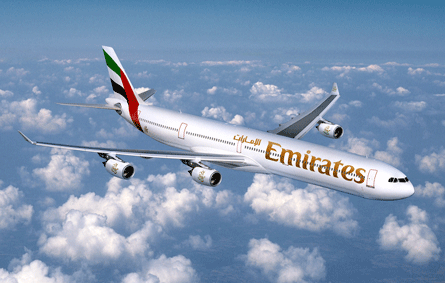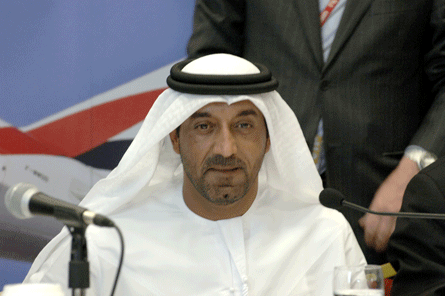The companies offering onboard mobile phone have had to jump through every regulatory hoop in sight to prove that their services are safe. But now the concept has passed muster with some of the most demanding airlines and airworthiness bodies in the world, writes BRENDAN GALLAGHER, and the floodgates are ready to open.
Onboard cellphone took two huge steps towards respectability in the run-up to the show with the news that Emirates had launched its long awaited service while Qantas had committed to offering the capability in its domestic fleet following a trial completed earlier this year.
The Emirates service – supplied by ARINC/Telenor joint venture AeroMobile, with Inmarsat satcoms providing the air-ground link – was inaugurated two weeks ago on Emirates flight EK751 between Dubai and Casablanca. It is the world’s first commercial onboard cellphone offering, and it represents the first time that voice calls – as opposed to the text messaging and email tested in past and present airline trials - have been enabled aboard an airliner in full commercial service.
Emirates Airbus A340 will soon be enabled for onboard cellphones |
Qantas declared that it would introduce the AeroMobile service on domestic aircraft from the end of this year, allowing passengers to send text messages and email from mobile phones and other devices such as BlackBerry's and wireless laptops. The Australian carrier currently has no plan to offer voice.
Emirates introduced its history-making service – which also includes text messaging - on one of its Airbus A340-300s following certification of the onboard picocell and associated equipment by the European Aviation Safety Agency (EASA) and the United Arab Emirates-based General Civil Aviation Authority (GCAA).
On the inaugural flight passengers were able to make and receive voice calls as well as use text messaging. The system automatically came into operation as the aircraft reached cruise altitude, and passengers received a text message welcoming them to the AeroMobile system when they first switched on their phones. Emirates has developed guidelines for the appropriate use of phones on board, including a request that they be switched to silent mode in flight. The cabin crew were able to monitor use of the system and were in full control of its use throughout.
A second Emirates aircraft, a Boeing 777-300, has been fitted with the system and will be ready to support the service soon. In the meantime, AeroMobile and the airline are working to add BlackBerry email and other GPRS data applications later this year and to integrate the system with Emirates’ Panasonic eX2-based ICE inflight entertainment service.
The Dubai-based carrier was moved to put its shoulder behind onboard cellphone by its positive experience with the Inmarsat-supported phones already wired into every seat in its fleet. “We are delighted to now offer our customers the choice of using their own mobile phones to contact friends, family or colleagues while flying with us,” Emirates chairman Sheikh Ahmed al-Maktoum said. “They are already making more than 7,000 calls a month from our in-seat phones, so we will be making life easier for those for whom staying in touch by mobile phone has become an important part of their everyday lives.”
Sheikh Ahmed, chairman of Emirates. Making life easier for those who want to stay in touch. |
Qantas has decided to adopt AeroMobile following a trial in a single domestic Boeing 767-300 that began in April last year and concluded at the end of January. During the trial GSM text messaging and GPRS data services were offered on more than a thousand flights. Now the carrier plans to start introducing these capabilities on its domestic aircraft before the end of the year.
“The evaluation was a great success,” Qantas general manager John Borghetti said. “An overwhelming majority of passengers involved in the evaluation indicated they wanted access to inflight connectivity. We are committed to meeting their needs by offering this technology, which will allow them to use their inflight time more effectively.”
The airline, AeroMobile, Panasonic and ground telecoms provider Telstra are now working to obtain full airworthiness and other approvals from Australian Civil Aviation Safety Authority (CASA), Australian Communications and Media Authority (ACMA) and other agencies. The system will then be installed on a number of 767-300s and Airbus A330-200s.
Screen star – what passengers see when they turn on their mobiles in the air. |
The news from Emirates and Qantas, brings to a happy conclusion a frustrating period for AeroMobile and Airbus/SITA rival OnAir, which have seen their systems come under exceptionally close scrutiny from airworthiness authorities worried by persistent anecdotes of interference with aircraft systems. At the same time, they have had to fend off pressure groups alleging that their services would lead inevitably to a rise in air rage incidents. These unequivocal votes of confidence from two of the world’s top airlines could now open the floodgates to a surge of adoption and implementation.
Besides Emirates and Qantas, AeroMobile says it has programmes under way with another five airlines, comprising Saudia, Turkish Airlines and three unnamed carriers. OnAir is currently being trialled aboard a single Air France aircraft within Europe, is due to begin trials soon with Ryanair, bmi and TAP Portugal, and has contracts with AirAsia and its AirAsia X long-haul arm, Kingfisher Airlines, Royal Jordanian, Shenzhen Airlines and an unnamed European low-fare operator.
More news, pictures and videos from Aircraft interiors EXPO Hamburg 2008....
Source: Flight Daily News


























